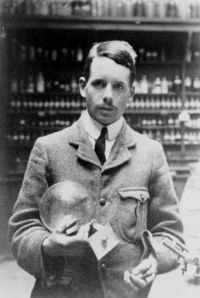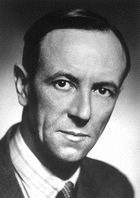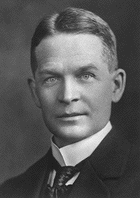อนุภาคมูลฐานของอะตอม
จากการศึกษาเกี่ยวกับโครงสร้างอะตอมในตอนแรก ทำให้นักวิทยาศาสตร์เชื่อว่าอะตอมประกอบด้วยอนุภาค 2 ชนิด
คือ อิเล็กตรอน และโปรตอน จนกระทั่งการศึกษาเกี่ยวกับอะตอมได้พัฒนาการมากขึ้น
จึงได้ทราบว่านอกจากจะมีอิเล็กตรอนและโปรตอนแล้วยังมีนิวตรอน และอนุภาคอื่น ๆ อีกหลายชนิด
จำนวนโปรตอนของธาตุ
ในปี พ.ศ. 2456 เฮนรี มอสเลย์ (Henry Mosley) นักวิทยาศาสตร์ชาวอังกฤษสามารถหาจำนวนโปรตอนที่มีอยู่ในแต่ละธาตุได้ โดยศึกษาจากสเปกตรัมรังสีเอกซ์ของธาตุ เมื่อนำจำนวนโปรตอนของธาตุมาพิจารณาร่วมกับแบบจำลองอะตอมของรัทเทอร์ฟอร์ดในแง่มวลของอะตอม จะพบว่า
- แบบจำลองอะตอมของรัทเทอร์ฟอร์ดยังไม่ถูกต้องนัก กล่าวคือตามแบบจำลองอะตอมของรัทเทอร์ฟอร์ด มวลของอะตอมก็คือ มวลของนิวเคลียส หรือมวลของโปรตอนอย่างเดียวนั่นเอง ถ้านิวเคลียสของอะตอมประกอบด้วยโปรตอนอย่างเดียว มวลของอะตอมก็น่าจะเท่ากับมวลของโปรตอนมารวมกัน
- แต่จากการทดลองหามวลของอะตอมพบว่ามวลอะตอมของธาตุต่าง ๆ มักจะมีค่ามากกว่ามวลของโปรตอนเสมอ เช่น
1. ธาตุคาร์บอนมีโปรตอน 6 ตัว ตามแบบจำลองอะตอมของรัทเทอร์ฟอร์ดมวลอะตอมควรจะมีค่าเป็น 6 หน่วย แต่จากการทดลองพบว่ามีมวลอะตอมถึง 12 หน่วย
2. ธาตุออกซิเจนมี 8 โปรตอน แต่มีมวลอะตอม 16 หน่วย
จากผลการทดลองพบว่าอะตอมของธาตุส่วนใหญ่จะมีมวลเป็น 2 เท่า หรือมากกว่า 2 เท่าของโปรตอน ทำให้รัทเทอร์ฟอร์ดตั้งข้อสันนิษฐานว่า ภายในอะตอมน่าจะมีอนุภาคอีกชนิดหนึ่งซึ่งไม่ใช่โปรตอนและอิเล็กตรอนอยู่ด้วย โดยที่อนุภาคนี้จะอยู่รวมกันในนิวเคลียส และมีมวลใกล้เคียงกับมวลของโปรตอน รวมทั้งเป็นกลางทางไฟฟ้าด้วย ซึ่งต่อมาก็ได้มีการพิสูจน์ข้อสันนิษฐานของรัทเทอร์ฟอร์ดจนยอมรับกันว่าเป็นความจริง

Henry Moseley.
Henry Moseley (1887-1915): A British chemist who studied under Rutherford and brilliantly developed the application of X-ray spectra to study atomic structure; his discoveries resulted in a more accurate positioning of elements in the Periodic Table by closer determination of atomic numbers. Tragically for the development of science, Moseley was killed in action at Gallipoli in 1915.
In 1913, almost fifty years after Mendeleev, Henry Moseley published the results of his measurements of the wavelengths of the X-ray spectral lines of a number of elements which showed that the ordering of the wavelengths of the X-ray emissions of the elements coincided with the ordering of the elements by atomic number. With the discovery of isotopes of the elements, it became apparent that atomic weight was not the significant player in the periodic law as Mendeleev, Meyers and others had proposed, but rather, the properties of the elements varied periodically with atomic number.
When atoms were arranged according to increasing atomic number, the few problems with Mendeleev's periodic table had disappeared. Because of Moseley's work, the modern periodic table is based on the atomic numbers of the elements.
การค้นพบนิวตรอน
ในปี พ.ศ. 2475 เจมส์ แซดวิก (James Chadwick) นักวิทยาศาสตร์ชาวอังกฤษ ได้ทดลองยิงอนุภาคแอลฟาไปยังธาตุชนิดต่าง ๆ โดยใช้เครื่องมือที่ละเอียดถูกต้องยิ่งขึ้น และพิสูจน์ได้ว่าภายในนิวเคลียสจะมีอนุภาคอีกชนิดหนึ่งซึ่งเป็นกลางทางไฟฟ้าอยู่ด้วย และ
เรียกอนุภาคนั้นว่า นิวตรอน

James Chadwick
James Chadwick was born in Cheshire, England, on 20th October, 1891, the son of John Joseph Chadwick and Anne Mary Knowles. He attended Manchester High School prior to entering Manchester University in 1908; he graduated from the Honours School of Physics in 1911 and spent the next two years under Professor (later Lord) Rutherford in the Physical Laboratory in Manchester, where he worked on various radioactivity problems, gaining his M.Sc. degree in 1913. That same year he was awarded the 1851 Exhibition Scholarship and proceeded to Berlin to work in the Physikalisch Technische Reichsanstalt at Charlottenburg under Professor H. Geiger.
In 1932, Chadwick made a fundamental discovery in the domain of nuclear science: he proved the existence of neutrons - elementary particles devoid of any electrical charge. In contrast with the helium nuclei (alpha rays) which are charged, and therefore repelled by the considerable electrical forces present in the nuclei of heavy atoms, this new tool in atomic disintegration need not overcome any electric barrier and is capable of penetrating and splitting the nuclei of even the heaviest elements. Chadwick in this way prepared the way towards the fission of uranium 235 and towards the creation of the atomic bomb. For this epoch-making discovery he was awarded the Hughes Medal of the Royal Society in 1932, and subsequently the Nobel Prize for Physics in 1935.
การค้นพบ ไอโซโทป
ทอมสัน ได้ทดลองเกี่ยวกับมวลของอนุภาคบวกที่ได้จากหลอดรังสีแคโทด พบว่า ในขณะที่ใช้ก๊าซนีออนใส่ในหลอดรังสีจะสามารถหามวลของอนุภาคบวกได้ถึง 2 ค่า คือ 20 และ 22 หน่วย ซึ่งแสดงว่าก๊าซนีออนจะต้องมีอะตอม 2 ชนิด ซึ่งมีมวลไม่เท่ากัน
ต่อมา เฟรเดอริก ซอดดี (Frederick soddy) ได้ตั้งชื่ออะตอมของธาตุชนิดเดียวกันแต่มีมวลต่างกันว่า ไอโซโทป ซึ่งถือว่าผลการทดลองนี้เป็นข้อมูลสนับสนุนข้อเสนอของรัทเทอร์ฟอร์ด ที่ว่าภายในนิวเคลียสควรจะมีอนุภาคอีกอย่างหนึ่ง ซึ่งมีมวลใกล้เคียงกับโปรตอนแต่ไม่มีประจุ

Frederick Soddy
Frederick Soddy, the son of Benjamin Soddy, a London merchant, was born at Eastbourne, Sussex, England, on September 2, 1877. He was educated at Eastbourne College and the University College of Wales, Aberystwyth.
In 1895 he obtained a scholarship at Merton College, Oxford, from which University he graduated in 1898 with first class honours in chemistry. After two years of research at Oxford he went to Canada and from 1900 to 1902 was Demonstrator in the Chemistry Department of McGill University, Montreal. Here he worked with Professor Sir Ernest Rutherford on problems of radioactivity. Together they published a series of papers on radioactivity and concluded that it was a phenomenon involving atomic disintegration with the formation of new kinds of matter. They also investigated the gaseous emanation of radium.
From 1904 to 1914 Soddy was lecturer in physical chemistry and radioactivity in the University of Glasgow. Here he did much practical chemical work on radioactive materials. During this period he evolved the so-called "Displacement Law", namely that emission of an alpha-particle from an element causes that element to move back two places in the Periodic Table. His peak was reached in 1913 with his formulation of the concept of isotopes, which stated that certain elements exist in two or more forms which have different atomic weights but which are indistinguishable chemically.
อนุภาคมูลฐานของอะตอม
| อนุภาค | สัญลักษณ์ | มวล | มวลเปรียบเทียบ | ประจุในหน่วย | ชนิดของ | ||
|
|
| kg | amu | กับอิเล็กตรอน | คูลอมบ์ | esu | ประจุ |
| โปรตอน นิวตรอน อิเล็กตรอน | p n e | 1.672 x 10-27 1.674 x 10-27 9.109 x 10-32 | 1.0073 1.0087 0.000540 | 1836 1839 | 1.602 x 10-19 0 1.602 x 10-19 | 4.8209x10-12 0 4.8209x10-12 | +1 0 -1 |
อนุภาคที่ไม่คงตัวในอะตอม
| อนุภาค | สัญลักษณ์ | มวล( amu.) | ประจุ (esu.) | ชนิดของประจุ |
| โพสิตรอน นิวตริโน มีซอน
ดิวทีรอน แอลฟา | e+ , b+ , +1e n p m
a , | 0.000540 - 0.156 0.118 2.01416 4.00276 | 4.8209 x 10-12 0 4.8209 x 10-12 4.8209 x 10-12 4.8209 x 10-12 9.6056 x 10-12 | +1 0 +1 , -1 +1 , -1 +1 +2 |